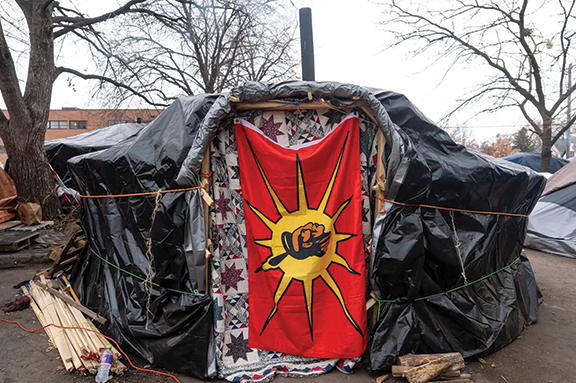
By Katelyn Vue/Sahan Journal and MPR News
An ambitious plan to coordinate Minnesota’s response to homelessness across agencies – shaped by those who have directly experienced housing instability – will swing into action this spring.
The “Crossroads to Justice” strategic plan aims to reduce homelessness statewide by 15 percent by 2026 and to narrow the large racial disparities in those experiencing homelessness. Another goal is to reduce the disparities in mortality and improve the health of people facing homelessness.
“This plan, which will be our north star for our state agencies, is comprehensive covering approaches like increasing shelter capacity, as well as how to approach related needs such as ensuring that addiction treatment and recovery resources are widely accessible,” Lieutenant Governor Peggy Flanagan said in a statement.
Last year, Governor Tim Walz signed a historic $2.6 billion housing stability package; some of those funds will fuel the plan’s action steps, including increased funding for homeless shelters, rental assistance, affordable housing and support to help people find and keep housing.
In 2022, Walz and Flanagan delegated the Minnesota Interagency Council on Homelessness (MICH), a cabinet-level state advisory group leading state efforts on housing stability, to launch efforts crafting the plan. Over the next four years, about a dozen state and regional agencies will work to implement the plan’s action steps to reduce barriers to benefits, housing and jobs, among other initiatives.
Agency-specific efforts range from better access to state workforce programs, to a pilot program to improve food assistance to those who cycle in and out of homelessness, to better housing and benefits for veterans, to more transitional housing for those leaving prison.
The plan will shape priorities during the next Legislative session, said MICH Executive Director Cathy ten Broeke, who has worked in state government and direct homelessness response for over 30 years.
The $2.6 billion state investment in housing efforts “is a huge down payment on this work,” she said.
Crossroads to Justice is the first plan of its kind to incorporate people who have experienced housing instability or homelessness justice consultants. The consultants will continue to be involved in the implementation stage.
One of the twelve justice consultants, Marlena Jasch, is an enrolled member of the Standing Rock Sioux Tribe who currently lives in St. Cloud.
Between 2017 to 2019, Jasch was homeless while on a housing waitlist. She said she struggled to find safe, available spaces in shelters in the rural communities where she lived including Melrose and Sauk Centre. She spent summers living in a tent and winters in her car.
In 2019, a rapid rehousing program helped her secure an apartment, she said. She was also on track to become a licensed practice nurse.
However, she said COVID-19 restrictions disrupted her plans. And after police responded to a domestic violence call at her apartment, her landlord filed to evict her. In 2021, she became homeless again for a couple of months. Jasch said in those months, she was still fleeing her abuser while they were stalking her.
She sought temporary housing at a local shelter for domestic violence survivors, but was turned down because “my actual domestic assault had not been within the last couple of days,” she said. She eventually found a place at a shared house.
“I brought that also into my experience as a consultant,” Jasch said, referring to domestic violence leading to homelessness. “It was important to me that that got brought to the table, and added to the list, but it was very new to be bringing that to [state agencies] and for them to be working on it as it relates to this plan.”
As a justice consultant, she specifically wanted to collaborate with the Department of Public Safety, Department of Corrections, Department of Human Services to create action steps. She also worked with the state department of administration.
One of the action steps resulting from working together is a Domestic Violence Housing First program that will be implemented through the Department of Human Services, which is trauma-informed and survivor-centered housing assistance that focuses on rapidly housing domestic violence survivors, then providing ongoing support services.
Her experience as a Native woman also shaped her approach, Jasch said.
In Minnesota, Native Americans are 28 times more likely to experience homelessness than non-Latino whites, according to the plan. Several of the plan’s action steps highlight increasing funding opportunities and expanding relationships with tribal nations and urban tribal communities.
“I felt like this process, first of all, gave power to the consultants but then in turn, we were able to encourage these large agencies, but also the individual employees working at these agencies, to see the importance of power-sharing and community,” said Michael Giovanis, one of the justice consultants who contributed to the report.






